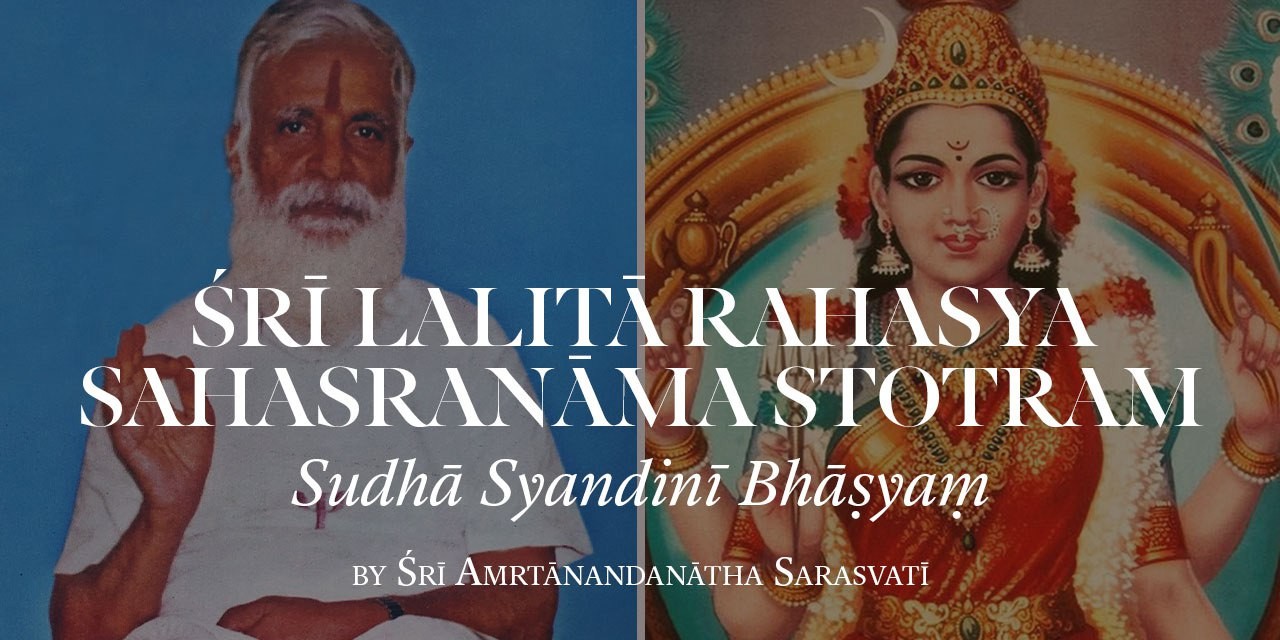
20) Tārākānti-tiraskāri-nāsābharaṇa-bhāsurā
In meditation Lalitā is the most aesthetically perfect, beautiful form one can ever hope to see. Of Her myriad beauties, there is none better than the rays of light emanating from the star She wears for a nose stud. It is important to note the color of the ray emanating from Her nose stud if you happen to see Lalitā in meditation, because it indicates your remaining samskaras or propensities, and the path which enables you to reach liberation. Broadly speaking, the meanings of colors are as follows.
White The upāsana will have to be mainly sattvic, indicates that you are already at an advanced stage of sādhana.
Violet Indicates a passionate temperament. You will do well not to curb your passions, but express them fully, at the same time offering your pleasures to Lalitā at the moments of your deepest ecstasy. Develop a deep passion for the Devi using madhura bhāva, meaning you are Her lover. You will use the mantra received from your Kula Guru to pace your pleasure seeking activities.
Blue Indicates that the path of vairagya, detachment, and renunciation is the best for you. You will follow the path of the divyas. Siddhis will be at your beck and call, but you will eschew using then.
Green The path is a mixture of jñāna (knowledge) and detachment. You will not renounce the world, but will continue in a detached way, learning much through experience.
Yellow The path is pure knowledge, no bhakti or devotion in it. You will be a vedantin, rather dry, logical one. Towards the very end you will develop bhakti.
Orange You will be a highly creative individual, forceful without being coercive in your human relations. You are likely to renounce at a late stage in life. Karma mārga appeals to you. You will use your powers of attraction for much human good.
Red Indicates love, harmony and passion. You will be devoted, know a lot from direct revelations, go beyond knowledge to wisdom and intuition. Eros will be your main mode of worship. You will contribute to much happiness, organize orgiastic modes of worship which are so close to the heart of Lalitā, the Goddess of Love. This is the color through which many materialistically oriented people can reach their salvation through orgasmic love.
There are different emotions you can have towards Godhead. The feelings of God as your protector and benefactor, as your parent, as your child, as your friend, as your lover, and yes, even as your enemy, not believing. All these moods are valid means, differing in effectiveness.
Among these, the lowest forms are those of protector and benefactor. It is said in Upaniṣads thus: “Those that maintain or wish to maintain a distinction between themselves and God, God appears as fear itself to them. Godhead treats them as animals for they are afraid of punishment and expect rewards like animals.”
Treating God as your parent or child has the advantage that you may take liberties with it, a stage higher than the first. Love leads to merger, but since physical union with formless God is rare, because God has to take form for this purpose, love leads to a mental union which sometimes has a reality even higher than the physical union.
The last mentioned feeling, of hate towards God or atheism, is probably the highest path. God will not tolerate the denial of itself for too long, it has to put an end to the misery of self separation quickly. In other cases, there is some happiness which fills the vacuum. Atheism on the contrary cannot be filled with happiness because the real source of all joy is being self denied. So existentialist recoils on itself. It has to be remembered that seeking for joy means seeking for God, because God is infinite joy. Real joy consists not in seeking for oneself, but in seeking joy for all. Is it not clear why this is so? If you seek joy for yourself alone, each is for himself only. But if you seek joy for all, each is for the many; so the joy goes as the square of the number of people. If the sphere of influence of one person is 100 say, there can be 10,000 times the joy the second way.
To conclude then, the path of spreading love, harmony and joy, of total self giving to fill the happiness of the others, the path of other centeredness is the recommended path for all those who can make it. If you care for others, if you love others physically, mentally, causally, by seeing God, the source of all joy in others, they cannot remain others any longer, they have to merge into you, the world has to collapse into the saintly lover. The object merges into the subject while the subject loses the address as such and such an individual.
Source: Śrī Amṛtānandanātha Saraswatī "Sudhā Syandinī Bhāṣyaṃ" Typed Manuscript
(an incomplete commentary on Lalitā Sahasranāma)
